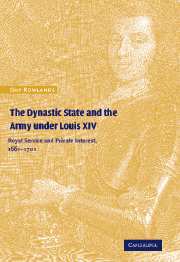Book contents
- Frontmatter
- Contents
- List of maps
- Acknowledgements
- List of abbreviations
- Family tree of the Le Tellier: 1. Principal branch
- Family tree of the Le Tellier: 2. Royal household marital connections
- Map 1 The French provinces under Louis XIV
- General introduction: ‘Absolute monarchy’, dynasticism and the standing army
- Part I ‘Patrimonial bureaucracy’: The Le Tellier dynasty and the Ministry of War
- Part II The forging of the French officer corps and the standing army under Louis XIV
- Part III The high command of the French armies
- Conclusion: The preservation of the dynasty
- Appendix 1 Defining the grands
- Appendix 2 The proportion of revenue generated by the Extraordinaire des Guerres as a ‘primary receiver’
- Bibliography
- Index
- CAMBRIDGE STUDIES IN EARLY MODERN HISTORY
General introduction: ‘Absolute monarchy’, dynasticism and the standing army
Published online by Cambridge University Press: 20 May 2010
- Frontmatter
- Contents
- List of maps
- Acknowledgements
- List of abbreviations
- Family tree of the Le Tellier: 1. Principal branch
- Family tree of the Le Tellier: 2. Royal household marital connections
- Map 1 The French provinces under Louis XIV
- General introduction: ‘Absolute monarchy’, dynasticism and the standing army
- Part I ‘Patrimonial bureaucracy’: The Le Tellier dynasty and the Ministry of War
- Part II The forging of the French officer corps and the standing army under Louis XIV
- Part III The high command of the French armies
- Conclusion: The preservation of the dynasty
- Appendix 1 Defining the grands
- Appendix 2 The proportion of revenue generated by the Extraordinaire des Guerres as a ‘primary receiver’
- Bibliography
- Index
- CAMBRIDGE STUDIES IN EARLY MODERN HISTORY
Summary
By 1693, the annus mirabilis of French battlefield victories in the seventeenth century, the army of Louis XIV was the largest organised military force Europe had ever seen. That year troop numbers topped 400,000 men on paper, and even in reality the army stood at about 320,000 men. It would not be surpassed in size either in France or in any other part of the continent until the republic which supplanted the Bourbon monarchy mobilised the country for another bout of coalition warfare one hundred years later.
At the very core of this book are three basic questions: how did the regime of Louis XIV create and fashion an army of such vast size out of the ramshackle forces which the ministries of Richelieu and Mazarin, lasting from 1624 to 1661, had bequeathed to him? Why, over the next forty years, did the army take the shape that it did? And what can a study of the army tell us about the nature of French government in the second half of the seventeenth century? At first glance these questions might appear quite simple. But one cannot hope to answer them by reference merely to the institutional development of the army and the War Ministry, as most scholars have hitherto tried to do.
- Type
- Chapter
- Information
- The Dynastic State and the Army under Louis XIVRoyal Service and Private Interest 1661–1701, pp. 1 - 24Publisher: Cambridge University PressPrint publication year: 2002



